Что такое Docker Desktop
Docker Desktop — это инструмент для работы с Docker-контейнерами на локальной машине. Он упрощает процесс разработки, тестирования и развертывания приложений, позволяя взаимодействовать с контейнерами как через консоль, так и через удобный интерфейс.
Ключевые особенности:
- понятный графический интерфейс,
- удобное управление образами и контейнерами,
- встроенные инструменты для мониторинга,
- возможность разработки и тестирования без привязки к серверу,
- поддержка работы с Docker Compose.
Если вы только начинаете изучение Docker и хотите разобраться в основах, рекомендуем ознакомиться с отдельным вводным обзором. В нем разобрали принципы работы Docker, его основные компоненты и решаемые задач. Из текста вы узнаете, как создать и запустить контейнер, а также какую роль играет Kubernetes в связке c Docker.
О системных требованиях
Перед установкой Docker Desktop важно выбрать подходящий бэкенд для работы с контейнерами: WSL 2 или Hyper-V. Оба имеют свои особенности, так что от выбора будут зависеть и системные требования. Далее в тексте разберемся, когда и какой бэкенд подойдет лучше.
Когда нужен WSL
WSL 2 (Windows Subsystem for Linux 2) — это усовершенствованная версия подсистемы Windows для Linux, которая использует виртуальную машину с реальным Linux-ядром. В отличие от первой версии, WSL 2 обеспечивает лучшую совместимость с Linux-инструментами, технологиями и приложениями, а также более высокую производительность.
Преимущества использования WSL 2 с Docker Desktop
Работа с Linux-контейнерами. Docker изначально разрабатывали для работы в Linux-среде, поэтому большинство контейнеров в Docker Hub — это образы, ориентированные на Linux. Использование WSL 2 предоставляет Docker Desktop полноценную Linux-среду на Windows.
Повышенная производительность. WSL 2 значительно ускоряет выполнение контейнеров, что особенно заметно в сравнении с WSL 1 или Hyper-V, о котором мы расскажем дальше. Это преимущество обеспечивает полноценное Linux-ядро, которое позволяет Docker работать гораздо быстрее и с меньшими накладными расходами.
Работа с файловой системой Linux. В WSL 2 можно монтировать файловую систему Linux, что позволяет работать с кодом и данными в нативной Linux-среде. Это особенно важно при разработке приложений, которые будут запускаться в Linux-контейнерах и требуют специфической настройки среды — например, прав доступа или структуры каталогов.
Когда нужен Hyper-V
Рассмотрим ключевые сценарии, в которых предпочтительнее использовать Hyper-V.
Если система не поддерживает WSL 2
Некоторые сборки системы не позволяют включать необходимые компонентов для работы WSL 2 В частности, это касается старых версий Windows, а также устройств, которые не поддерживают Windows 10 Pro или 11 Pro, — WSL 2 для них недоступна, так как требует включенной виртуализации на уровне системы. В таких случаях можно использовать Hyper-V для виртуализации контейнеров и запуска Docker Desktop.
Для работы с Windows-контейнерами
Docker Desktop поддерживает как Linux-, так и Windows-контейнеры. Однако последние требуют прямого взаимодействия с ядром Windows, а WSL 2 предоставляет только Linux-среду. Hyper-V позволяет запускать Windows-контейнеры благодаря виртуализации Windows-системы.
Для изоляции и обеспечения безопасности
Hyper-V создает полноценные виртуальные машины, обеспечивая строгую изоляцию контейнеров друг от друга и от хост-системы. Это может быть важно в корпоративной среде или при работе с чувствительными данными.
Разница между WSL 2 и Hyper-V
Если вам нужны Linux-контейнеры и высокая производительность — выбирайте WSL 2. Если же требуется строгая изоляция или работа с Windows-контейнерами, Hyper-V будет предпочтительнее. Подробнее о разнице по ключевым критериям — в таблице:
| Критерий | WSL 2 | Hyper-V |
| Производительность | Высокая (нативное Linux-ядро) | Низкая (работа через полноценную ВМ) |
| Изоляция | Относительно низкая | Высокая (контейнеры изолированы) |
| Типы контейнеров | Только Linux-контейнеры | Linux- и Windows-контейнеры |
Системные требования Docker Desktop
При использовании WSL 2 в качестве бэкенда
- WSL версии 1.1.3.0 или новее.
- Windows 11 64-bit Home / Pro / Enterprise / Education, версия 22H2 или новее.
- Windows 10 64-bit Home / Pro / Enterprise / Education, версия 22H2 (сборка 19045) или новее.
- Включенная функция WSL 2 в Windows. Подробная инструкция есть в документации Microsoft;
- 4 ГБ ОЗУ.
- Включенная аппаратная виртуализация в BIOS на вашей локальной машине.
При использовании Hyper-V в качестве бэкенда
- Windows 11 64-разрядная Enterprise / Pro / Education, версия 22H2 или новее.
- Windows 10 64-разрядная Enterprise / Pro / Education, версия 22H2 (сборка 19045) или новее.
- Включенная функция Hyper-V. Подробнее об установке — в документации Microsoft;
- 4 ГБ ОЗУ.
- Включенная аппаратная виртуализация в BIOS на вашей локальной машине.
Установка WSL 2
1. Откройте PowerShell от имени администратора и введите команду wsl —install. Она выполняет следующие действия:
- включает дополнительные компоненты WSL и платформы виртуальных машин;
- скачивает и устанавливает последнюю версию ядра Linux;
- задает WSL 2 в качестве среды по умолчанию;
- скачивает и устанавливает дистрибутив Ubuntu Linux.
2. После успешной установки всех компонентов перезапустите компьютер.
Первичная настройка
1. Откройте установленный дистрибутив с помощью меню Пуск — найдите установленный дистрибутив (Ubuntu).
2. При первом запуске системы нужно создать имя пользователя и пароль для дистрибутива Linux.
3. Первичная настройка завершена, можно приступать к использованию WSL 2.
Альтернативный вариант — запустить WSL через PowerShell. Для этого введите команду wsl и система предложит произвести первичную настройку.
Установка Hyper-V
Для установки компонентов Hyper-V откройте PowerShell от имени администратора и выполните команду:
Enable-WindowsOptionalFeature -Online -FeatureName Microsoft-Hyper-V -All
Она установит все компоненты для работы Hyper-V, после чего нужно будет перезапустить компьютер.
Проверить корректность установки Hyper-V можно с помощью команды:
Get-WindowsOptionalFeature -Online -FeatureName *hyper*|ft
Установка Docker с бэкендом WSL 2
- Скачайте дистрибутив Docker Desktop с официального сайта и запустите установщик. Галочки оставьте на всех пунктах.
- После установки перезайдите в учетную запись и откройте ярлык Docker Desktop.
- Если все прошло успешно, вы увидите интерфейс инструмента:
Установка Docker с бэкендом Hyper-V
1. Скачайте дистрибутив Docker Desktop с официального сайта и запустите установщик. В инсталляционном окне уберите галочку Use WSL 2 instead of Hyper-V.
2. После установки перезайдите в учетную запись и откройте ярлык Docker Desktop.
3. Если установка выполнена корректно, программа запустится без ошибок и вы увидите интерфейс:
Запуск контейнера
Рассмотрим запуск первого контейнера на примере самого популярного образа — hello-world.
Поиск и скачивание образа
Поскольку вы только установили Docker Desktop, в системе нет образов контейнеров, которые можно запустить. Исправим это.
- Перейдите в раздел Images и нажмите кнопку Search images to run.
- Введите hello-world. В текущем окне на выбор есть две кнопки: Pull и Run. Если планируете для начала просто скачать образ, то выбирайте Pull. Если скачать и сразу запустить — Run.
- Оставляем стандартные настройки для запуска.
Проверка работы контейнера
Чтобы посмотреть запущенные контейнеры, перейдите во вкладку Containers и выберите созданный на прошлом этапе. В нашем примере для него было автоматически сгенерировано имя determined_jennings. Открыв контейнер, вы увидите сообщение, если настройка установка прошла успешно.
Как настроить запуск Docker при старте Windows
Для автозапуска Docker Desktop при авторизации на компьютере достаточно поставить галочку в настройках: Settings → General → Start Docker Desktop when you sign in to your computer.
После этого Docker Desktop будет запускаться автоматически при включении устройства.
Запуск Docker в облаке
Docker Desktop — удобный инструмент для локальной работы, но в ряде случаев может потребоваться облачная инфраструктура:
- если мощности вашего ПК не хватает для работы с контейнерами;
- если нужна среда для тестирования без нагрузки на локальную машину;
- если вы работаете с ML/AI и нужны видеокарты для обучения моделей.
1. В панели управления в верхнем меню перейдем в раздел Продукты → Облачные серверы.
2. Нажмем кнопку Создать сервер.
3. Выберем имя, регион и сегмент пула. Важно учесть, что от сегмента зависят доступные конфигурации и стоимость. После создания сервера менять сегмент пула нельзя.
4. В качестве источника выберите готовый образ, приложение, свой образ, сетевой диск или снапшот. В нашем случае — приложение Containers Ready с настроенной Ubuntu 22.04. Оно содержит:
- Docker версии 27.0.3;
- плагины для запуска Docker Compose версии 2.11.1;
- Portainer версии 2.20.3 — графический интерфейс для мониторинга и управления Docker-контейнерами, образами и сетью Docker.
5. Конфигурацию для примера возьмем базовую — 2 vCPU и 2 ГБ RAM, а в поле Диски выберем SSD Быстрый на 20 ГБ. Важно: это минимальные требования. Рекомендуем выбирать параметры серверы, исходя из ваших задач.
Помимо прочего, на этапе создания сервера или позже вы можете добавить GPU. При этом объем ОЗУ, который выделяется серверу, может быть меньше указанного в конфигурации — ядро ОС резервирует ее часть. Выделенный объем на сервере можно посмотреть с помощью команды sudo dmesg | grep Memory.
6. Для работы Containers Ready сервер должен быть доступен из интернета. Для этого создадим приватную подсеть и подключим публичный IP-адрес. В поле Сеть выберем Приватная подсеть и добавим новый публичный адрес. Подробнее о настройке подсети можно узнать в документации.
6. Добавьте SSH-ключ в поле Доступ. Подробнее о его генерации можно узнать в отдельной инструкции.
7. Ознакомьтесь с ценой и нажмите кнопку Создать сервер.
Сервер готов к использованию! Подробности о создании сервера с Сontainers Ready вы можете найти в документации. Если вам нужно запускать контейнеры с ML-моделями на мощных видеокартах, развернуть облачные серверы с GPU можно за несколько минут. Они помогут ускорить обучение нейросетей без закупки дорогого оборудования.
Читайте другие тексты о Docker
Есть два варианта установки платформы контейнеризации Docker на Windows 10 и 11: в виде нативного win приложения Docker Desktop for Windows (используется встроенные компоненты Hyper-V + контейнеры Windows), или в виде полноценной установки Docker Engine в дистрибутив Linux в подсистеме Windows Subsystem for Linux (WSL2). В этой статье мы рассмотрим процесс установки и базовой настройки Docker в среде WSL без использования Docker Desktop.
Преимущества от запуска Docker внутри WSL:
- Docker Desktop требует Pro или Enterprise редакции Windows 10 (11). Docker Engine в WSL будет работать на домашних (Home) редакциях Windows
- Docker Desktop для Windows потребляет довольно много RAM и места для хранения отдельных виртуальных машин Hyper-V (в случае использования Windows контейнеров)
- Лицензионные ограничения позволяют бесплатно использовать Docker Desktop для персональных проектов, или в небольших организациях (до 250 сотрудников). В других случаях нужно приобрести лицензию.
Итак, предполагаем что у вас есть компьютер с Windows 10 и 11, на котором вы установили среду Windows Subsystem for Linux (WSL2) и скачали один из доступных Linux образов (Ubuntu 24.04 в этом примере). Выведите список доступны дистрибутивов WSL:
wsl --list
Чтобы задать образ WSL, который будет использоваться по-умолчанию, выполните команду:
wsl --setdefault Ubuntu-24.04

Убедитесь, что используется версия WSL2:
wsl --version
Если нет, выполните команду:
wsl --set-default-version 2
Чтобы подключиться к вашему дистрибутиву Linux в среде WSL, выполните:
wsl.exe
Обновите пакеты в дистрибутиве Linux (Ubuntu в этом случае):
$ sudo apt-get update && sudo apt-get upgrade -y
Затем выполните установку Docker Engine в Linux с помощью универсального официального скрипта:
$ curl -fsSL https://get.docker.com -o get-docker.sh
$ sudo sh get-docker.sh
Игнорируйте появившееся предупреждение об установке Docker в среде WSL.

Добавьте вашего пользователя в группу docker чтобы получить возможность запускать команды docker без повышения привилегий и ввода пароля через sudo:
$ sudo usermod -aG docker $USER
Проверьте, что Docker desktop и compose установлены успешно:
$ docker --version
$ docker compose version

Теперь нужно настроить автоматически запуск docker в WSL. В современных дистрибутивах Linux для WSL2 добавлена полноценная поддержка systemd. Проверьте, что он включен:
$ cat /etc/wsl.conf
[boot] systemd=true

Затем проверьте, что systemd используется в качестве системы инициализации Linux:
$ stat /sbin/init
В данном используется systemd, т.к. процесс /sbin/init это символьная ссылка на /lib/systemd/systemd.

Запустите сервис docker engine и включите автоматический запуск:
$ sudo systemctl enable --now docker.service
$ systemctl status docker.service
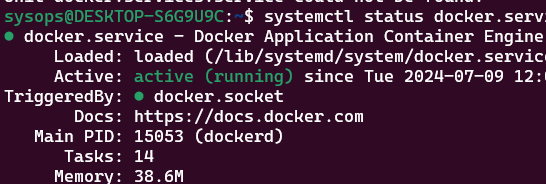
Если systemd не используется по той или иной причине, можно добавить его в автозагрузку WSL:
$ nano /etc/wsl.conf
[boot] command = "/usr/sbin/service docker start"
WSL2 по-умолчанию может использовать следующие ресурсы компьютера:
- 50% оперативной памяти
- 25% файла подкачки (swap)
- 100% ресурсов процессора
Если вы хотите ограничить использование ресурсов хоста подсистемой WSL2, создайте в профиле текущего пользователя текстовый файл
%UserProfile%\.wslconfig
. В этом файле можно задать глобальные ограничения для всех дистрибутивов в WSL. Например:
[wsl2] memory=8GB processors=4 swap=2GB
Перезапустите образ WSL из командой строки Windows:
wsl --shutdown
Попробуйте запустить тестовый docker образ в WSL:
$ docker run hello-world
Docker Engine скачает и запустит демонстрационный контейнер hello-world из Docker Hub.
Для обеспечения максимального производительности WSL2, храните все файлы контейнеров внутри WSL (а не в директориях, которые пробрасываются с Windows, таких как /mnt/c).
В современных версиях Linux (Ubuntu 22.04, Debian 10+) для управления встроенным файрволом используется nftables, а не iptables. Для нативной поддержки nftables в WSL требуется ядро Linux 5.8 или выше. В старых версиях ядра для корректной работы сети придется включать совместимость с iptables:
$ sudo update-alternatives --config iptables

Нажмите 1 для выбора режима iptables-legacy.
Теперь вы можете выполнять команды к docker в WSL из командной строки Windows. Перед командами docker нужно указывать wsl. Например, вывести список доступных образов в Docker:
wsl docker images

Теперь вы можете разрабатывать и запускать Docker контейнеры непосредственно на своем Windows компьютере.
Рассмотрим установку Docker Desktop for Windows — это Community-версия Docker для систем Microsoft Windows.
Системные требования
- Windows 10 64-bit: Pro, Enterprise, Education (Build 16299 или выше).
Для успешного запуска Client Hyper-V в Windows 10 требуются следующие предварительные требования к оборудованию:
- 64 bit процессор c поддержкой Second Level Address Translation (SLAT).
- 4GB системной памяти.
- Поддержка аппаратной виртуализации на уровне BIOS должна быть включена в настройках BIOS.
Подготовка
Включаем функции Hyper-V Containers Window. Для этого переходим в панель управления – установка и удаление программ – включение или отключение компонентов Windows. Активируем пункт Hyper-V, который включает Hyper-V Managment Tools, Hyper-V Platform.
Также это можно выполнить через powershell или dism (все команды необходимо выполнять с правами администратора).
Powershell:
Enable-WindowsOptionalFeature -Online -FeatureName Microsoft-Hyper-V -All
DISM:
DISM /Online /Enable-Feature /All /FeatureName:Microsoft-Hyper-V
Установка
Скачиваем установщик Docker (Docker Desktop Installer) с Docker Hub.
Установка Docker Desktop включает Docker Engine, Docker CLI client, Docker Compose, Notary, Kubernetes и Credential Helper. Контейнеры и образы, созданные с помощью Docker Desktop, используются всеми учетными записями пользователей на компьютерах, на которых он установлен. Это связано с тем, что все учетные записи Windows используют одну и ту же виртуальную машину для создания и запуска контейнеров. При использовании Docker Desktop WSL 2 невозможно обмениваться контейнерами и образами между учетными записями пользователей.
Запускаем установщик Docker Desktop Installer.exe и ожидаем пока он скачает все необходимые компоненты.
После установки система потребует перезагрузки. Перезагружаемся и входим в систему.
После входа может возникнут запрос на установку дополнительного компонента WSL2. Переходим по ссылке и скачиваем необходимый пакет с официального сайта Microsoft.
После скачивания выполняем установку WSL2, после которой снова потребуется перезагрузка.
Настройка и запуск приложения
Входим в систему и ждем запуска всех служб Docker. Когда все службы будут запущены, мы увидим в трее классический значок Docker — это значит что служба установлена и запущена. Далее можно запустить приложение Docker desktop. Далее можно изменить настройки Docker при необходимости:

Рисунок 1 — Изменение параметров Docker desktop
Далее управление Docker выполняется через Powershell. Проверяем версию и выполняем тестовый запуск контейнера:

Рисунок 2 — Проверка версии Docker
После выполнения всех этих действий, Docker готов к использованию.
Нужна помощь? Настройки docker/docker swarm/docker compose мы осуществляем в рамках услуги DevOps-аутсорсинг.
Docker is a powerful platform that allows you to develop, ship, and run applications inside lightweight containers. Install Docker on Windows to create consistent development environments, streamline deployment processes, and enhance system efficiency.
This guide will provide step-by-step instructions for installing Docker on Windows using the GUI or the command line.
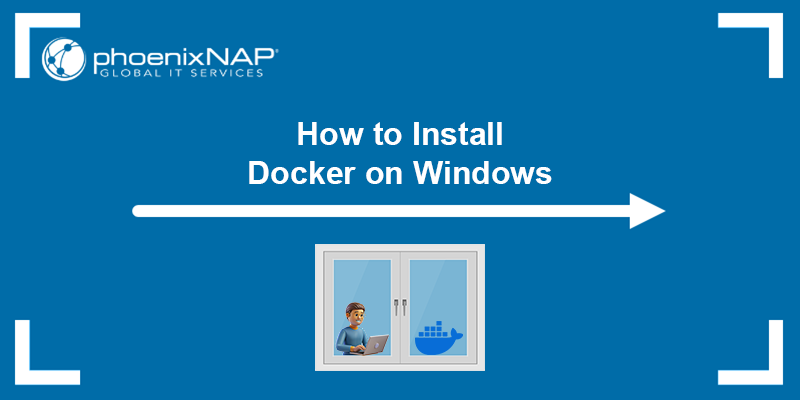
Prerequisites
- A machine running Windows 10 22H2 or Windows 11.
- At least 4GB of RAM.
- A user account with administrator privileges.
- WSL 2 enabled.
Install Docker Desktop on Windows via GUI
Installing Docker via a GUI is simple, with a full desktop app, and it is great for beginners and GUI users. It involves downloading the Docker Desktop Installer from the official website and installing the program through a wizard.
Follow the steps in the sections below.
Step 1: Download Docker Desktop Installer
Download the Docker Desktop Installer for Windows x86/x64 from the official Docker website.
Note: A paid subscription is required if you plan to use Docker Desktop in large enterprises with over 250 employees or if your annual revenue exceeds $10 million USD. Docker is free for personal use, small businesses, and education. Refer to the official page for pricing details.
Step 2: Install Docker Desktop
The steps below will guide you through the installation process:
1. Find and double-click the downloaded installer to start the installation.
2. The installer initializes, and the configuration screen appears, allowing you to customize your setup.
Keeping the default options checked is recommended, as WSL 2 offers faster performance, better integration with the Windows filesystem, and uses fewer system resources compared to Hyper-V.
Uncheck the box to use Hyper-V instead if you need to run traditional Windows-based virtual machines or if you require stricter isolation and security controls than WSL’s.
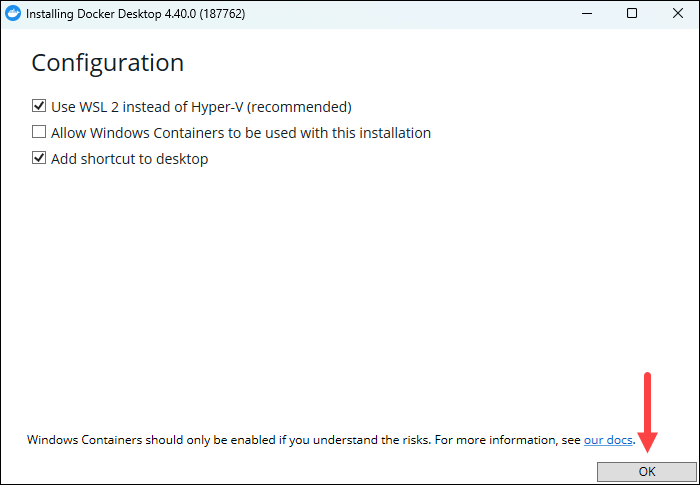
Click OK to start the installation.
3. When the process completes, click the Close and restart button to close the installer and reboot Windows for the changes to take effect:
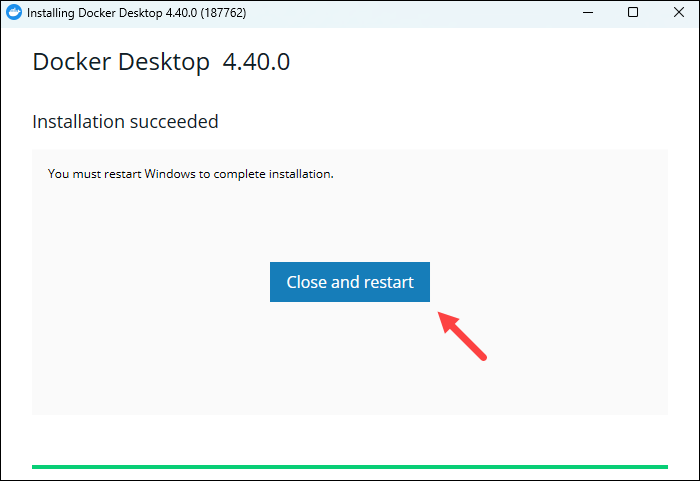
Step 3: Start Docker Desktop
After installation, start the Docker tool manually:
1. Press the Windows button and type Docker desktop to find the app.
2. Open the Docker Desktop app from the search results.
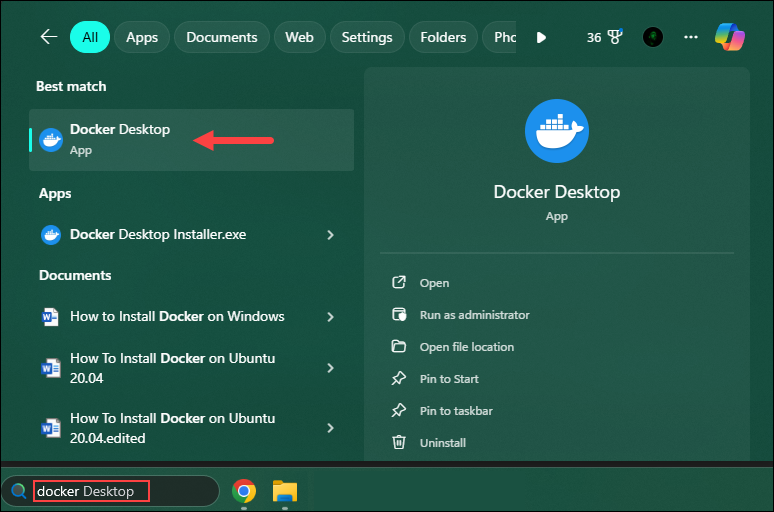
3. The app requires you to accept the Docker Subscription Service Agreement first. If you agree with the terms, click Accept to proceed.

4. The app presents a Welcome survey. The survey is optional, and you can click Skip in the top right corner to move on to the sign-in step.
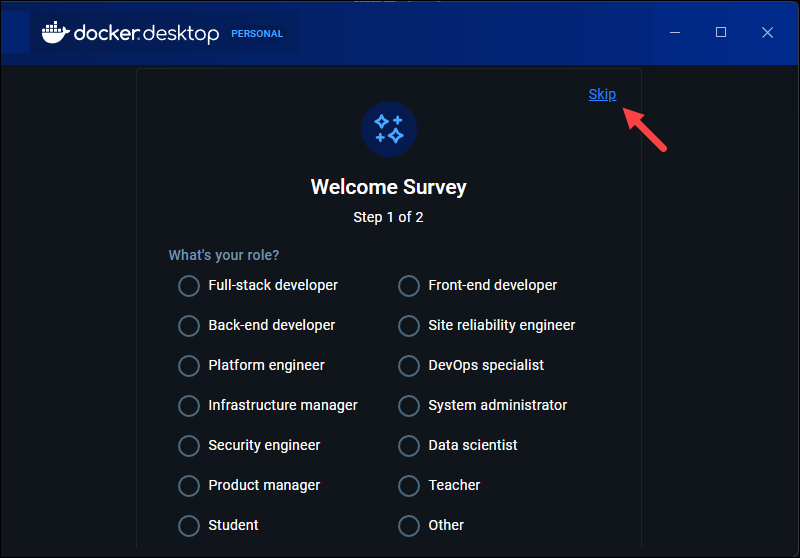
5. The Welcome to Docker screen appears, where you can sign in to Docker if you already have an account or create a new account. Complete the sign-in process to finish the installation.
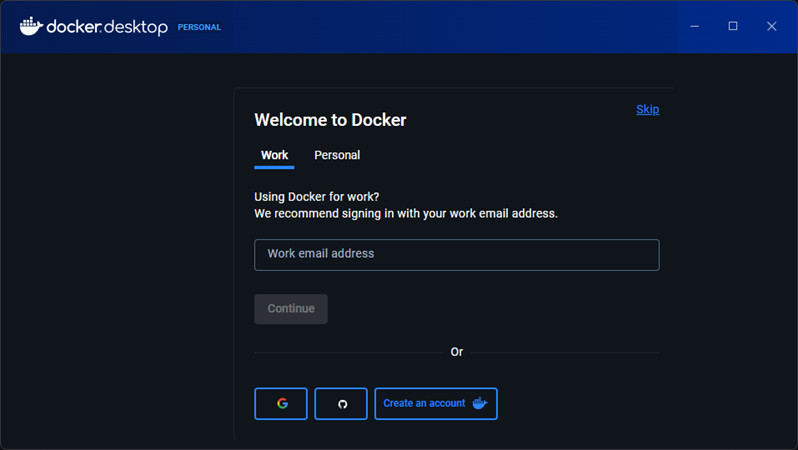
6. After signing in, the Docker Desktop dashboard opens, which means Docker Desktop is successfully running on Windows.
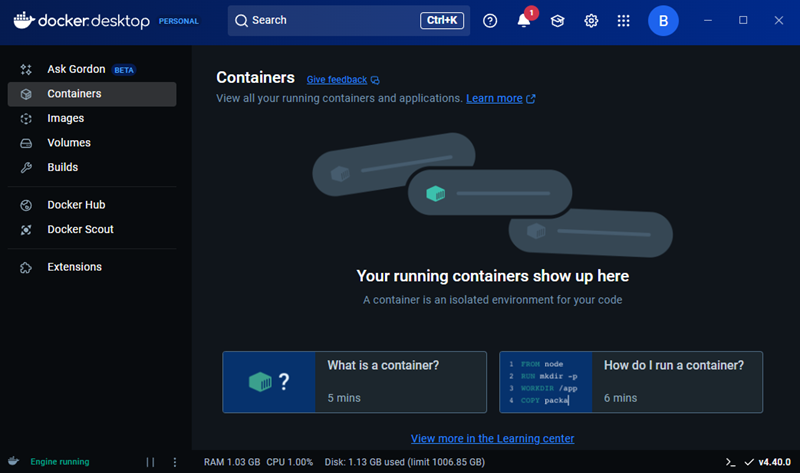
Install Docker Desktop via CLI
This method shows a terminal-based, manual setup that installs Docker in a Linux environment inside Windows, without using the GUI installer. The installation is silent, via PowerShell, and it is ideal for sysadmins or DevOps users who want automation or script-based installs.
Note that Docker still runs on Windows through the Docker Desktop app (with GUI components), even if it is installed and started via the terminal.
Step 1: Download the Installer
Download the Docker Desktop Installer and save it in an easily accessible location. Remember the path as you will need it in the following step.
Step 2: Install Docker
After you download the installer, there are two ways to install Docker Desktop, depending on which command line option you want to use:
Windows PowerShell
1. Open PowerShell as an administrator and use the cd command to navigate to the folder in which you downloaded the installer.
2. Run the command below to install Docker Desktop:
Start-Process 'Docker Desktop Installer.exe' -Wait --quiet install3. If prompted, click OK to complete the installation.
Command Prompt
1. Open Windows Command Prompt as an administrator and navigate to the installer location.
2. Run the command below to start the installation:
start /w "" "Docker Desktop Installer.exe" install3. When prompted, click OK to finish the installation.
The default installation location for Docker Desktop is C:\Program Files\Docker\Docker.
Step 3: Add User Account
If your admin account and user account are not the same, use the syntax below to add user accounts to Docker user groups:
net localgroup docker-users [user] /addReplace [user] with the respective username.
Step 4: Start Docker Desktop
Open the Docker Desktop app and sign in to your account to enable the Docker engine. Follow the steps outlined in Step 3: Start Docker Desktop section above, and when you finish, you can start using Docker.
Step 5: Verify Docker Installation
To verify that Docker installed correctly, pull a sample image. In PowerShell or the Command Prompt, run the command below:
docker pull nginx
If the image pulls successfully, Docker Desktop has been installed correctly.
Install Docker on Windows via Command Line
This method shows how to bypass Docker Desktop completely and install the Docker Engine inside a Linux environment (Ubuntu on WSL). Installing Docker inside a Linux environment is closer to how Docker works natively on Linux systems. It is ideal for developers who want a lightweight, GUI-free, native-Linux experience or dislike Docker Desktop’s licensing or resource overhead.
Follow the steps in the sections below.
Step 1: Enable WSL
If you do not have WSL enabled, you must first install it. Open PowerShell or Windows Command Prompt as an administrator and run the following command:
wsl --installThe command enables the required features for running WSL and installs the default Linux distro (Ubuntu).
If you want a specific Linux distribution, you can specify it using the -d flag. In this tutorial, we will use Ubuntu 24.04:
wsl --install -d Ubuntu-24.04
Step 2: Initialize Distro and Create User
After the installation, it is time to set up the Linux distribution.
1. Press the Windows button and type Ubuntu to find the distribution. Press Enter to initialize it.
2. After the instance initializes, it prompts you to create a new default user account. Provide the username and password to start using Ubuntu within WSL.
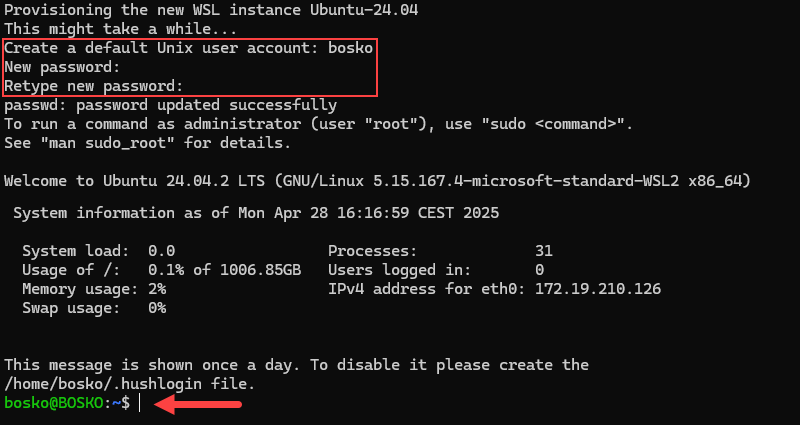
Step 3: Install Docker
After initialization, the system is ready for Docker installation. Follow the steps below:
1. Update the system package index with:
sudo apt update2. Install the dependencies:
sudo apt install ca-certificates curl3. Set the permissions for the /etc/apt/keyrings directory that will hold the GPG key:
sudo install -m 0755 -d /etc/apt/keyrings4. Download the GPG key:
sudo curl -fsSL https://download.docker.com/linux/ubuntu/gpg -o /etc/apt/keyrings/docker.asc5. Change the key permissions:
sudo chmod a+r /etc/apt/keyrings/docker.asc6. Add the Docker repository to apt sources:
echo \
"deb [arch=$(dpkg --print-architecture) signed-by=/etc/apt/keyrings/docker.asc] https://download.docker.com/linux/ubuntu \
$(. /etc/os-release && echo "${UBUNTU_CODENAME:-$VERSION_CODENAME}") stable" | \
sudo tee /etc/apt/sources.list.d/docker.list > /dev/null7. Refresh the package index one more time to pull information from the Docker repository:
sudo apt update8. Install Docker and all required packages:
sudo apt install docker-ce docker-ce-cli containerd.io docker-compose-plugin docker-buildx-pluginWait for the installation to complete. For more detailed instructions on enabling non-root access and a QuickStart guide on using Docker in Ubuntu, refer to our tutorial for installing Docker on Ubuntu.
If you have installed a different distribution on WSL, refer to our guides for installing Docker on Raspberry Pi, Rocky Linux and CentOS, or Debian.
9. After you set up and customize the installation to your needs, verify the installation with:
docker --versionThe output should print the Docker version if the installation completed successfully:

Conclusion
This tutorial showed how to install Docker on Windows using the GUI or the CLI. Installing Docker on Windows allows users to benefit from streamlined development processes, reliable application deployment, and greater operational efficiency.
Next, learn how to check and reduce Docker image size or set up and use a private Docker registry. If you already use Docker, download our handy Docker commands cheat sheet.
Was this article helpful?
YesNo
Before understanding the concept of Docker, let’s first discuss the concept of Hypervisors. So in an IT Company, or any cooperation, there is a development team, a testing team, and an operation team for developing the application, testing it, and deploying it. Now suppose the developers are working on a different OS, for example, let’s say macOS, and they used some dependencies or libraries as per the language they are using, so they just won’t hand the software to the testing team, but also the libraries, But now, the application didn’t run the tester’s machine, but it worked on the developer’s machine, maybe because the tester’s machine has different OS features than the developer’s one.
In this article, we will guide you through on firstly discussing what is docker, what are the requirements to docker for installing in Windows, why to install docker on windows, its implementation guide, best practices and troubleshooting issues and much more, The following is the table of content, helping you to give a overview what we going to cover in this article.
Table of Content
- What is Docker?
- Requirements of Windows For Downloading Docker
- Specifications for Docker Desktop Installation
- Why to Install Docker on Windows?
- How to Install Docker Desktop on Windows? A Step-By-Step Guide
- How to Start Docker Desktop?
- How to Install Docker Desktop from the Command Line?
- How to Install Docker on Windows 10?
- How to Install Docker on Windows 11?
- How to Update the Docker in Windows?
- Advantages of Docker In Windows
- How to Uninstall the Docker Desktop Tool? A Step-By-Step Guide
- How to Install and Enable WSL 2 on Windows
- How to Install Docker With WSL 2 Backend on Windows?
- How to Install Docker on Windows Without Docker Desktop? A Step-By-Step Guide
- What’s the difference between Docker for Windows and Docker on Windows?
- Best practices of using Docker on Windows
- Common Troubleshooting Issues Related to Docker on Windows

But the problem here is, for every application, one needs a different OS, this will result in a waste of resources as multiple OSs will be running. So for this problem, we have the concept of Containers, the difference between Hypervisors and containers is that we don’t need multiple OS for every application, multiple applications can share the same OS kernel, can’t they? So instead of installing HYPERVISOR, we will be installing Docker.

What is Docker?
Docker is an open-source container platform software tool, where you run your applications in the form of containers. Docker containers comes with light weighted softwares having all the dependencies and configurations so we can run them across different computing environments. It facilitates the developers to package their application with all its dependencies into a single entity in the form of images. These can be portable easily or sharable with other developers without worrying about the underlying OS.
Requirements of Windows For Downloading Docker
The following are the requirements of Windows on Docker:
- Windows 11 64-bit: Home or Pro version 21H2 or higher, or Enterprise or Education version 21H2.
- Windows 10 64-bit: Home or Pro version 21H2 or higher, or Enterprise or Education version 21H2.
- 4GB RAM or Higher.
- Hyper V feature must be enabled in Windows.
Specifications for Docker Desktop Installation
The following are specifications for installing Docker on windows:
- RAM: The minimal amount of Memory needed to run containers smoothly is 4GB, however, if a program has more complicated functions, it will need more than 6 GB RAM.
- Storage: For running the containers and installation of docker the minimum space required is 25GB. If you want to store the container images and data then we need at least more than 35 GB to 40 GB.
- Network: To download, push, and pull the images we need active internet then only we can maintain the container images with the help of docker.
- CPU: At least a 64-bit processor is required for docker.
Docker can be run on a laptop with 4 GB of Memory, a 64-bit processor, and 25 GB of storage. It might change based on our use cases.
Why to Install Docker on Windows?
The following are the some of the reasons and insights specifying the needs and uses of installing the docker on windows:
- Consistent Environments: It ensure the applications to run smoothly across different systems without any compatibility issues.
- Resource Efficiency: It uses less resources compared to virtual machines, which facilitates with allowing for faster startups and better resource utilization.
- Enhanced Collaboration: It facilitates with easy sharing and replication of development setups among teams.
- Seamless Integration: It facilitates to work well with existing Windows development tools and workflows
How to Install Docker Desktop on Windows? A Step-By-Step Guide
The following are the steps to guide for installing the Docker Desktop on Windows:
Step 1: Download Docker Desktop
- Open your preferred web browser (e.g., Chrome).
- Then search in the browser by typing s “Docker download” and press Enter.
- Click on the first link that appears in the search results.
Step 2: Select Software Respective to your OS
- On the Docker download page, select “Windows” as your operating system.
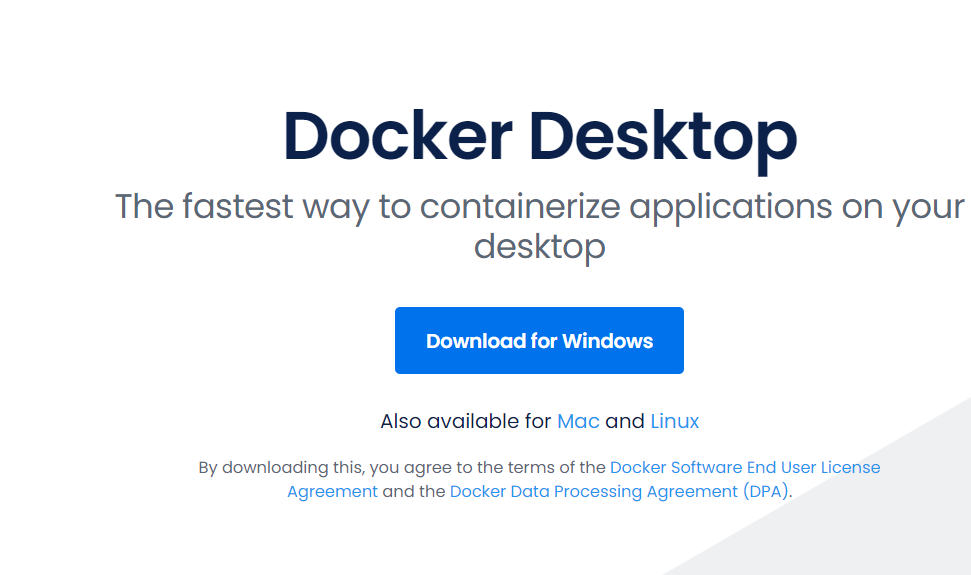
Step 3: Start the Download
- The download will begin automatically. The duration will depend on your internet speed.
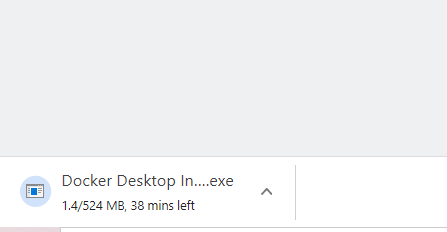
How to Start Docker Desktop?
Step 4: After installation, open Docker Desktop.
- Accept the Docker Subscription Service Agreement window and click “Continue.”
- Docker Desktop will start after accepting the terms and conditions.
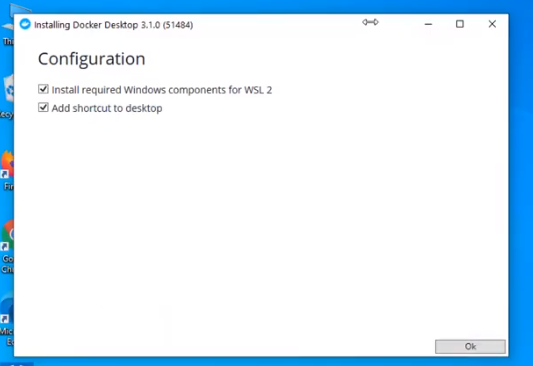
Step 5: After clicking “OK,” the installation will start.
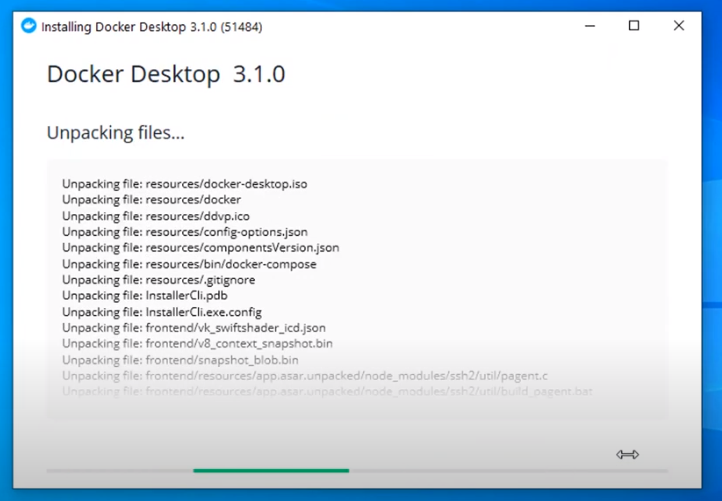
Step 6: After installation completes, it will show a confirmation screen.

Step 7: Restart your PC to install WSL 2 (Windows Subsystem for Linux), a compatibility layer for running Linux binary executables natively on Windows 10.
Step 8: After restarting, a dialog box will appear. Click the “Stop Docker” button.
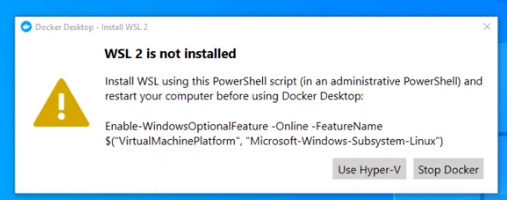
Step 9: Enable Hyper-V
- Restart your PC and enter the BIOS setup:
- Navigate to Settings > Update and Security > Recovery > Advanced Setup > Device Configuration.
- Ensure the “Enable Turbo Boost on DC” option is marked. Save and exit.
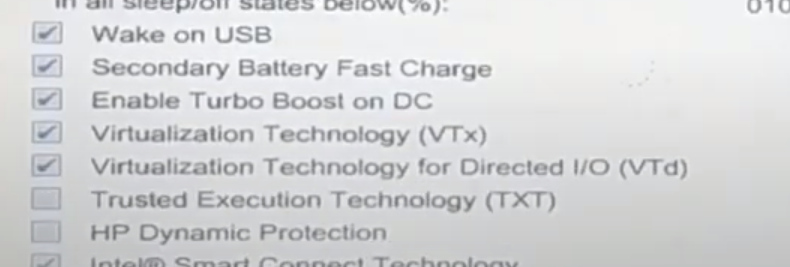
Step 10: Activate Hyper-V
- Go to Control Panel > Turn Windows Features on or off.
- Check “Hyper-V” and “Windows Hypervisor Platform.”
How to Install Docker Desktop from the Command Line?
To install Docker Desktop, follow these procedures:
Step 1: Run the following command in the Command Prompt:
start /w "" "Docker Desktop Installer.exe" install
Step 2: Add the user account to the Docker user group:
net localgroup docker-users <users>/add
Step 3: Verify Docker Installation and Versions
- Open the Command Prompt.
- Run the following command to check the Docker version:
docker --version
- Upon starting Docker for the first time, you will receive a Beta invitation email.
How to Install Docker on Windows 10?
You must perform the following steps in order to install Docker on Windows 10:
Step 1: Ensure Compatibility
- Verify that your system meets the minimum requirement for Docker: 64-bit Windows 10 Pro.
Step 2: Download Docker
- Download Docker Desktop from the official website.
Step 3: Install Docker Desktop
- Complete the installation process.
- Open Docker Desktop from the Start menu.
- Enable Hyper-V and Windows Subsystem for Linux (WSL) features when prompted.
- Docker Desktop will automatically restart after enabling these features.
Step 4: Verify Installation:
- Open a command prompt or PowerShell window.
- Pull a sample image, such as Nginx, using the following command:
docker pull nginx
- If the image pulls successfully, Docker Desktop has been installed correctly.
How to Install Docker on Windows 11?
First, make sure that your Windows matches Docker’s requirement Docker requires 64-bit Windows 11 Pro, and the rest of all the steps are the same as Windows 10 as follows:
You must perform the following steps in order to install Docker on Windows 10:
Step 1: Ensure Compatibility
- Verify that your system meets the minimum requirement for Docker: 64-bit Windows 10 Pro.
Step 2: Download Docker
- Download Docker Desktop from the official website.
Step 3: Install Docker Desktop
- Complete the installation process.
- Open Docker Desktop from the Start menu.
- Enable Hyper-V and Windows Subsystem for Linux (WSL) features when prompted.
- Docker Desktop will automatically restart after enabling these features.
Step 4: Verify Installation
- Open a command prompt or PowerShell window.
- Pull a sample image, such as Nginx, using the following command:
docker pull nginx
- If the image pulls successfully, Docker Desktop has been installed correctly.
How to Update the Docker in Windows?
By following the steps mentioned below we can update our Docker:
Step 1: Open Docker Desktop from the Start menu
Step 2: Click on Settings and navigate to the “Resources” tab. Click on “Check for Updates.” Docker Desktop will check for any available updates.
Step 3: If an update is available, click “Download and Install.” Docker Desktop will automatically download and install the update. After completion, you can verify the Docker version by using the following command in Command Prompt or PowerShell:
docker version
Advantages of Docker In Windows
The following are the advantages of Docker in Windows:
- Docker for Windows allows developers to their applications easily on any Windows.
- Docker can be installed very easily on Windows.
- Docker containers can be moved in between Windows and Linux without changing the Source code.
- The application is isolated from the underlying OS which makes it more secure.
The following are the steps to uninstall the docker Desktop Tool:
Step 1: Find “Add or Remove Programs” in the start menu and choose it.
Step 2: Click Docker Desktop when you see Docker in the list of installed programs.
Step 3: Click on Uninstall in Docker Desktop and follow the on-screen instructions.
Step 4: After the uninstallation is complete, restart the computer.
How to Install and Enable WSL 2 on Windows
Before installing docker by using WSL 2 make sure your Windows is supported for that and then install and enable WSL2 on your laptop.
Step 1: Enter the following command as an administrator to enable the Windows Subsystem for Linux feature.
dism.exe /online /enable-feature /featurename
:Microsoft-Windows-Subsystem-Linux /all /norestart
Step 2: In this step, you need to enable the virtual machine platform feature to enable it to run the following command in Powershell as an administrator
dism.exe /online /enable-feature /featurename
:VirtualMachinePlatform /all /norestart
Step 3: After running the above command you need to restart your computer by this the virtual machine platform feature will be enabled.
Step 4: Download and install the WSL 2 Linux kernel updated package from the official website of Microsoft
Step 5: Make WSL 2 the standard version. Run the following command when logged in as an administrator in Windows PowerShell. Install a Linux distribution by using the Microsoft Store. You can pick from a variety of Linux distributions, including Kali Linux, Debian, and Ubuntu.
wsl --set-default-version 2
- After completing the above steps we can use execute Linux commands on your Windows using WSL 2.
How to Install Docker With WSL 2 Backend on Windows?
Utilizing dynamic memory allocation will help the WSL 2 backend consume resources more efficiently. which enables us to launch Docker very quickly and improve Docker’s speed. To make this happen please follow the steps mentioned below.
Step 1: Install and enable WSL 2 on Windows by following the steps outlined in the previous answers. And install Docker Desktop as mentioned above for Windows.
Step 2: Once the Docker Desktop installation is completed open the settings in Docker Desktop click on the resources tab and click on WSL 2 integration. Click “Apply & Restart” to apply the changes.
Step 3: Open a terminal in your WSL 2 distribution and use the following command to confirm that Docker is operational after Docker Desktop has restarted.
docker pull ubuntu
- If the image is successfully retrieved, WSL 2 has likely been deployed as a backend for Docker. The WSL 2 backend now allows you to use Docker to construct and manage containers on your Windows computer.
Note: The Docker CLI interacts with the Docker daemon running in the Windows Docker Desktop application when you issue Docker commands in your WSL 2 terminal.
How to Install Docker on Windows Without Docker Desktop? A Step-By-Step Guide
The following are the steps that guide you in installing the Docker on Windows without Docker Desktop:
Step 1: Enable WSL 2
- Open the power shell as administrator and run the following command:
wsl --install
Step 2: Install a Linux Distribution
- Download and install a Linux distributions from the Microsoft Store (e.g., Ubuntu)
Step 3: Set a WSL 2 as Default
- Open the PowerShell and set WSL 3 as the default version
wsl --set-default-version 2
Step 4: Install Docker Engine on WSL 2
- Open your linux distribution and update the packages list:
sudo apt update
- Install the docker using the a shell script as per defining, It looks as follows:
curl -fsSL https://get.docker.com -o get-docker.sh
sudo sh get-docker.sh
Step 5: Start Docker Service
- Start the docker service with the following command:
sudo service docker start
Step 6: Verify Installation
- Using the following command check the docker version for verifying the installation.
docker --version
Step 7: Run Docker Commands from Windows
- Install `wsl` command line tool to run the docker commands from the windows command prompt or PowerShell:
wsl docker run hello-world
What’s the difference between Docker for Windows and Docker on Windows?
The following are the difference between docker for windows and docker on windows:
| Aspect | Docker for Windows | Docker on Windows |
|---|---|---|
| Environment | It will run Docker containers using a lightweight VM (Hyper-V/WSL 2). | It will run the Docker containers natively on Windows Server. |
| Compatibility | It is suitable for development and testing on Windows 10/11. | It is suitable for production environments on Windows Server. |
| Performance | It used as a VM, which might have slight overhead compared to native. | It runs natively with offering better performance and integration. |
Best practices of using Docker on Windows
The following are the some of the best practices of using Docker on Windows:
- Use WSL2 Feature: Try to utilize the features of Windows Subsystem for Linux 2 (WSL2) for experiencing better performance and having compatibility to the applications.
- Optimize Docker Resources: Make adjustments to your resources such as CPU, memory, and disk settings in Docker Desktop for balancing performance and resource usage.
- Keep Docker Updated: Try to update the Docker Desktop software regularly, so that your containers can be ensured with security while acessing the new features.
- Utilize Docker Compose: Make use of Docker Compose for managing multi-container applications efficiently.
The following are the some of the common troubleshooting issues related to docker on windows:
- Hyper-V or WSL2 Not Enabled: Make sure the Hyper-V or WSL2 is enabled in Windows features section for successful installation and work properly with docker.
- Docker Desktop Won’t Start: Try to restart the Docker Desktop or check for updates to resolve startup issues.
- Network Connectivity Problems: Ensure to configure the network settings or to reset Docker to fix connectivity issues.
- Insufficient Disk Space: Try to free up the space or increase disk allocation for Docker.
Conclusion
In this article, we covered a step-by-step procedure to install docker in Windows 11 and Windows 10. We also covered how to install docker in Windows 10 and 11 with the help of the Command line. Refer to Install in Mac and Ubuntu to know more about installation in different Operating Systems.
